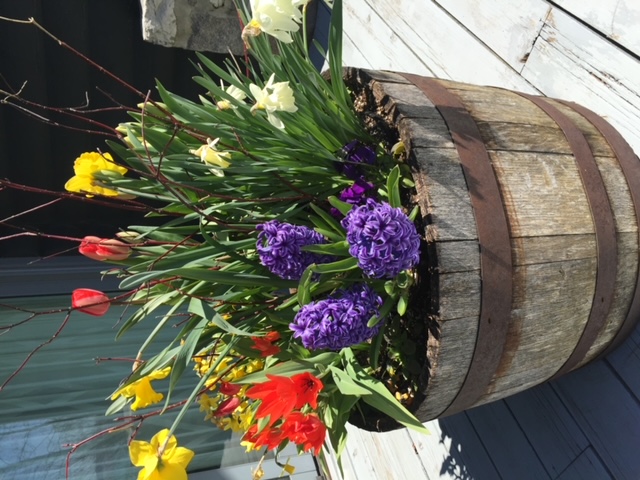Fall Planted Bulb Pots Show Off in the Spring
- bethcowie
- May 5, 2023
- 3 min read
According to the calendar, spring officially arrives in March with the Vernal Equinox, but here in Northern Michigan, March typically doesn’t offer us “spring-like” weather. So, there’s a special joy when the spring bulbs start to pop out in April and May and offer their colorful blooms.

Garden Club Member, Rhea Dow, has a clever way to curate those spring bulbs to create a beautiful living floral arrangement that will brighten your spring landscape, porch, or patio. She plants tulips, daffodils, hyacinths, and other spring-blooming bulbs in shallow plastic pots in the fall and then sinks the pots into the garden – allowing them to rest there through the winter. In the early spring, the pots are dug out and placed on her patio, by the front door, or she gives them as gifts to friends.

To reap this colorful reward, you have to think (and plant) a couple of seasons ahead, but it’s more than worth the effort when you are able to enjoy gorgeous early-season color around your home.

Here is the process and some tips for success:
When planting the bulbs in the fall, use shallow plastic pots with drainage holes. Clay pots will break when they freeze.
To keep the outside of the pot clean, cover it with a plastic bag (cutting a hole in the bottom of the bag to allow for drainage).
Select early-blooming varieties of tulips, daffodils, and minor bulbs. Some of Rhea’s favorites are: daffodil Tête-à-tête, tulip Praestens Fusilier, Glory of the Snow Chinodoxa Lucilias.
Place four to five inches of soil in the pot, place bulbs close together, and cover the bulbs with potting soil.
Sink the entire pot of bulbs in your garden or anywhere for easy access in the spring.
You may have to protect the pots with netting or chicken wire to prevent squirrels, rabbits, and deer from stealing your bulbs!
In early spring, dig out the pots and enjoy!
You can place the shallow pots in larger/deeper planters to create beautiful still-life style arrangements.
When the blooms have faded you can plant the bulbs (along with their foliage) in your garden – where they will bloom again next spring. Daffodils are safe to plant in areas that have deer traffic. The foliage should not be cut back until it has dried out. This allows the plant to store a food supply for next year. Tulips do not naturalize as daffodils do, and they are a deer favorite, so it is not typically worth trying to regrow them in the garden.

The Charlevoix Area Garden Club sells spring-blooming bulbs each October at Apple Fest. This fall come out to East Park and support the club while you plan your spring planters!
DAFFODIL (Narcissus spp.)
The cheerful trumpet-shaped flowers of daffodil are a sure sign of spring. There are hundreds of varieties in a wide array of sizes and forms, with colors of yellow, white, orange, peach, and bi-colors. These reliable hardy bulbs are easy to grow and long-lived, providing many years of spring color in the landscape.
TULIP (Tulipa spp.)
Tulips bloom in nearly every color except true blue. There are 100 species and thousands of cultivars, from dwarf forms to stately Darwin hybrids. This bulb combines well with other spring blooming bulbs, early perennials and annuals. However, tulips are a deer favorite, so must be protected in the garden.
HYACINTH (Hyacinthus orientalis)
Hyacinth is one of the most intensely fragrant spring bulbs, with spiky clusters of star-shaped flowers. Hyacinth blooms in blue, purple, red, pink, orange, coral, yellow, and white. This easy care bulb combines well with other spring bulbs that bloom at the same time, such as daffodils and early tulips. Plant where the sweet fragrance can be enjoyed up close.
GLORY OF THE SNOW (Chionodoxa spp.)
Glory of the snow is one of the earliest bulbs to flower and is named for its ability to poke out from underneath the cover of snow. Clusters of star-shaped upward-facing flowers occur in colors of blue, pink, or white. Plants are exceptionally hardy and naturalize readily.
GRAPE HYACINTH (Muscari armeniacum)
Grape hyacinth is named for the tiny clusters of fragrant flowers that resemble grapes. The deep blue flower coloring is highly coveted, complementing many other spring blooming bulbs such as daffodils and tulips. OtherMuscarispecies occur in shades of white, pink lavender, or yellow. In the landscape group masses of 25 or more for the best effect. Easy to grow, hardy, and reliable.





















Comments